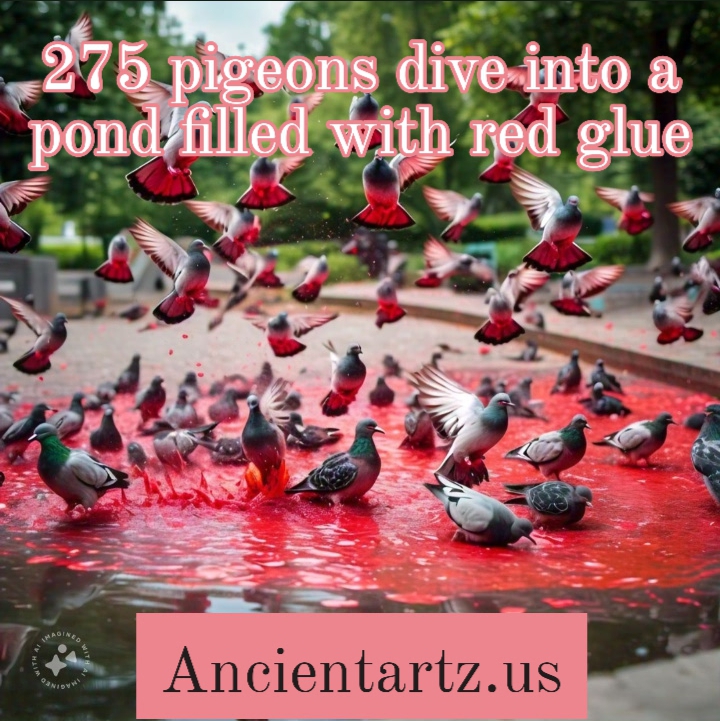Introduction: In a peculiar and bewildering event that left onlookers shocked and intrigued, 275 pigeons dove into a pond filled with red glue. This unusual incident caught the attention of people worldwide, stirring both concern for the birds’ well-being and curiosity about275 pigeons dive into a pond filled with red glue the bizarre circumstances that led to this strange spectacle. The question that arises in the minds of many is: How did this happen, and why did the pigeons react in such a way? Was it a simple accident, or is there something more to this unusual scenario?
In this article, we will explore this event in depth, breaking it down step by step. From understanding the behavior of pigeons to the scientific explanations behind275 pigeons dive into a pond filled with red glue the occurrence, we’ll cover everything you need to know about this astonishing phenomenon. So, let’s dive right in and uncover the mystery behind the 275 pigeons and the red glue-filled pond.
What Led to the Pond of Red Glue?
The first and most pressing question is: What caused the pond to be filled with red glue? Normally, a pond is a natural habitat for birds, but the sudden presence of a thick, sticky substance in the water can easily attract or trap animals, causing a dangerous situation. This was no ordinary pond—it was filled with an artificial substance, and the situation raised immediate concerns about its environmental impact.
In some cases, red dye or glue might be used as part of an art project, industrial activity, or an accident. If this pond was used for an industrial purpose, it’s possible 275 pigeons dive into a pond filled with red glue that the glue was used in the surrounding areas, either for construction purposes or as part of a chemical experiment gone wrong. Regardless of the origin of the red glue, its presence posed a significant threat to the wildlife and the birds that encountered it.
Pigeons and Their Instinctive Behavior:
Pigeons are curious creatures, often found in urban environments, scavenging for food or shelter. Known for their homing ability and flocking tendencies, pigeons are social275 pigeons dive into a pond filled with red glue animals that tend to follow each other when something catches their attention. When one pigeon spots something interesting, others are likely to follow suit, even if the object is dangerous.
In this case, the birds might have been attracted to the colorful appearance of the red glue, mistaking it for food or water. Pigeons have an excellent sense of sight and 275 pigeons dive into a pond filled with red glue may have been drawn to the pond’s vibrant color. The presence of 275 pigeons all at once suggests that they may have been reacting to the same visual stimulus, unaware of the danger the substance posed.
Additionally, pigeons are often seen in large flocks, and this behavior is part of their survival mechanism. In situations where one pigeon finds a new source of food or water, the others in the flock are likely to follow it without question. This behavior is driven by instinct, not logic, and can lead to collective actions that seem irrational from a human perspective.
The Effects of Red Glue on Pigeons:
Red glue, being a thick and sticky substance, likely posed significant dangers to the pigeons once they came into contact with it. Not only is glue harmful to the birds’ feathers, but it can also interfere with their ability to fly or even lead to suffocation. For a bird like a pigeon, whose feathers are crucial for its survival and ability to navigate, getting stuck in glue could be disastrous.
As the birds dove into the pond and became covered in red glue, they likely found themselves immobilized. The glue would have clung to their feathers, making it difficult for them to fly or move freely. This sticky substance could have trapped the pigeons in the pond, preventing them from escaping or returning to their natural environment. In some cases, the glue might even cause long-term damage to their feathers, leading to problems in grooming or potential exposure to cold temperatures.
The effects of glue on the birds’ health would depend on the chemicals present in the glue. If the glue was toxic, it could cause internal damage, leading to long-term health problems. In extreme cases, it could even be fatal if the birds ingested the glue while attempting to clean themselves.
How Did This Incident Impact the Local Environment?
The presence of red glue in a pond, especially in such large quantities, can have far-reaching consequences for the local environment. The glue not only posed a risk to the pigeons but also had the potential to affect other species that rely on the pond as a water source. For example, aquatic life, such as fish or amphibians, could have been harmed by the glue, either by ingesting it or coming into contact with the toxic substance.
In addition to the immediate harm caused to wildlife, the environmental impact could also extend to the broader ecosystem. The glue may have disrupted the natural balance of the pond, affecting its ability to support plant life and other animals. The presence of a foreign substance in such a delicate environment could lead to long-term ecological damage.
Efforts to clean up the pond and remove the glue would be necessary to prevent further harm to the wildlife and restore the natural habitat. Such an event highlights the importance of proper waste disposal and the need to be mindful of the potential dangers posed by chemicals in natural environments.
Rescue Efforts and Intervention:
Once the scale of the incident became apparent, authorities and animal rescue organizations likely sprang into action. The rescue efforts would have involved removing 275 pigeons dive into a pond filled with red glue the pigeons from the pond and carefully cleaning them of the glue. Since pigeons rely on their feathers for flight and insulation, cleaning them would be a delicate task, requiring the right tools and solutions to remove the sticky substance without causing further harm.
Rescuers would have to work quickly to ensure that the pigeons were not exposed to the glue for too long, as prolonged exposure could cause irreversible damage. Depending on the severity of the situation, veterinary professionals might have been needed to assess the health of the affected birds and treat any injuries caused by the glue or the environment.
Additionally, the cleanup of the pond would have been a priority to prevent further contamination of the area. Specialists in environmental remediation may have been called in to remove the glue and ensure that the water was safe for other wildlife and the surrounding ecosystem.
The Lessons Learned from the Incident:
This surreal event serves as a reminder of the importance of environmental awareness and the impact that human activities can have on wildlife. The incident highlights the need for better oversight in managing industrial materials, waste, and other potentially harmful substances that could end up in natural habitats.
For the pigeons, this serves as a lesson in the dangers275 pigeons dive into a pond filled with red glue of blindly following instinct and acting without fully understanding the potential risks. The event could also raise awareness about the challenges faced by urban wildlife in navigating environments that are increasingly influenced by human activities.
Conclusion:
The phenomenon of 275 pigeons diving into a pond filled with red glue is a bizarre and unsettling event, raising questions about the safety of 275 pigeons dive into a pond filled with red glue wildlife in urban areas. Whether caused by an accident or human error, the incident reminds us of the interconnectedness of the environment and the need for greater awareness and responsibility in our actions. By learning from such events, we can work together to protect our ecosystems and ensure that future generations of animals are not exposed to unnecessary harm.
FAQs:
1. Why did the pigeons dive into the pond filled with red glue? The pigeons likely mistook the red glue for a food or water source due to its color and consistency, prompting them to dive into the pond without understanding the danger.
2. What are the effects of glue on pigeons? The glue can severely harm pigeons by sticking to their feathers, making it difficult for them to fly or clean themselves. If toxic, the glue could also cause internal health problems.
3. How can the environment be affected by the presence of glue in a pond? The glue can harm not only the pigeons but also other wildlife that depends on the pond. It can disrupt the aquatic ecosystem, harming fish and plant life, and potentially leading to long-term environmental damage.
4. How can pigeons be rescued from glue? Rescue teams would need to carefully remove the pigeons from the pond and clean the glue from their feathers using safe and appropriate methods. Veterinarians may need to assess the health of the birds.
5. What should we do to prevent such incidents in the future? Improved waste management, awareness about the impact of chemicals on wildlife, and better regulation of industrial activities can help prevent such incidents and protect the environment.


